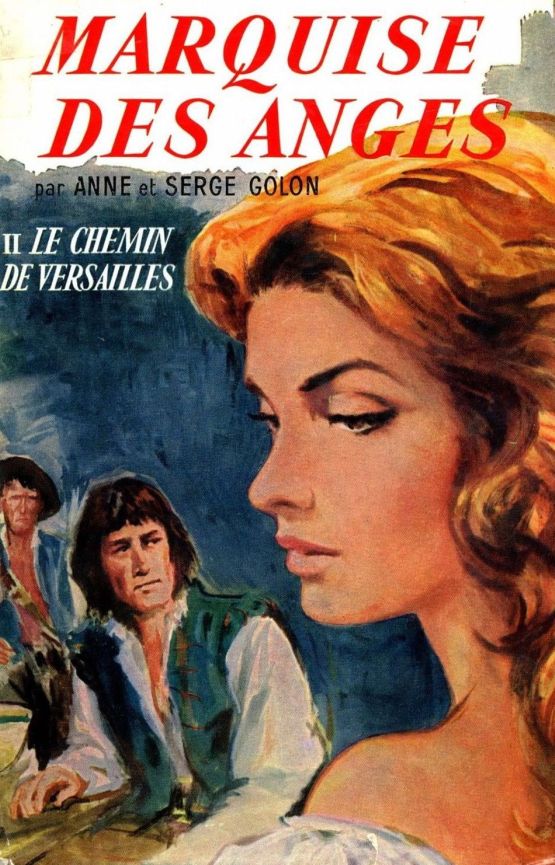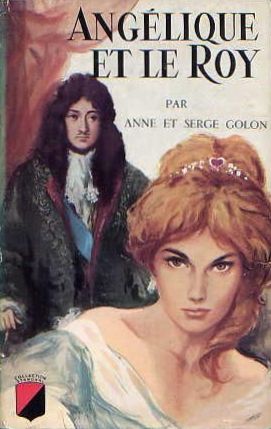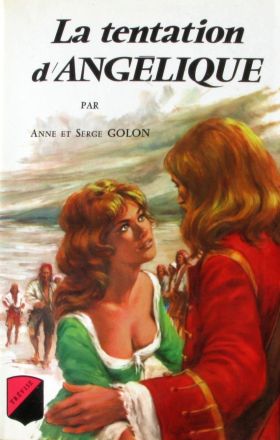
|
|
|
|
|
|
|
|
||||||||
The novel series Angélique: The brief annotations of the original editions

Angélique, The Marquise of the Angels (1957)
The first part consists simultaneously the four story lines, therefore now this novel is divided into the four comprehensive books in new edition. Already in the entrance part which introduces the reader not only to the idyllic life of the landed gentry in the region of Poitou, the author introduces the exciting, mysterious, magical atmosphere into which belong also the scenes from environment of the darkened monastery in Poitiers.
Like most of the then girls, seventeen year old Angélique is against her will married to the mysterious Count de Peyrac, who primarily scares her. Her fear and resistance, they are gradually turning into true love and Angélique is experiencing happiness in the palace of a progressive and charming nobleman of Aquitaine, of a traveler, scientist and philosopher with the political and business capabilities.
The third element is the Royal wedding in St-Jean-de-Luz, and for the first time there is coming to the fore a key figure of the whole work - the King of the Sun and of the France, Louis XIV. The shining environment up to now is suddenly replaced by the dark dungeons of a prison, where is the Count de Peyrac getting into and after that, he is convicted of witchcraft in the fictional process. This plot introduces the readers to an other political context of the time.

Angélique, The Road to Versailles (1958)
Spatially divided into two parts. The book starts on a place called the Court of Miracles, where all the scum and criminals of Paris are gathering around the left shore of the Seine and the tower of Nesle. On this place Angélique found herself when her husband was burned at the stake on the Place de Grève as a sorcerer. The instinct of self-preservation will learn her to gain a place among dubious elements.
Despite, an ambitious woman longs for a better place under the sun. She is reaching the position as an innkeeper in the connecting part of the story, and even, very soon, she trades with chocolate which is just getting into fashion. She is friends with Ninon de Lenclos, La Fontaine and the other authors. Angélique buys up the shares of shipping companies and leads her businesses, with that brings us to the socio-economic context of time of the Colbert's reforms.
And at that time, it is only little step to the road to Versailles and to the Court, where she belongs. For this, it can help her the wedding with a beautiful cousin, the king's army officer Philippe du Plessis-Bellière, whom she had secretly loved as a little girl in Poitou.

Angélique and the King (1959)
The short marriage with complicated Philippe du Plessis-Bellière brings unexpectedly a strong psychological plot, which also defines the style of this part. The dramatic story is mingling with the humorous situations which are caused by a thoughtful protocol of life at the Court of the Sun King.
We are gradually revealing a lot about the personality and practices of the King, who has just left his first official mistress, Louise de La Vallière. And it's time when it begins a period heyday of Versailles, which is associated with her successor, Madame de Montespan. Angélique has got soon to understand that behind the shining characters of gallant nobles in wigs and lace with their cultivated manners, there are hiding a competitive struggles for higher positions, slander, extortion, poisoning or fashion flirtation with Satanism.
In addition, there is another disclosure waiting on her which the King himself confided to her. It concerns her only love, Joffrey de Peyrac. Angélique gains new hope and decides to leave the Court where she managed to achieve the highest honors thanks to her personality and the King's weakness for beautiful women.

The Indomitable Angélique (1960)
ANGÉLIQUE AND THE SULTAN / ANGÉLIQUE IN BARBARY
Again spatially divided into two main parts. The book begins in a situation when Angélique leaves the Court and sets out to the Mediterranean to search for her first husband, who is perhaps alive. For this, it will help her a property of the office of consul in Candia and also the meeting with Monsieur de Vivonne, an organizer of the Versailles festivities and an Admiral of royal galleys. We can know a historical atmosphere of the island Malta – the seat of the Order of the Knights of Malta; an atmosphere of Crete, of the Greek Islands dotted with the ancient monuments including the life of the local population; but also an atmosphere of all the dangers which the pirates symbolized primarily. They trade with everything including people.
And just to them, Angélique is getting into their hands and she is sold as a popular assortment of white slave woman in the market in Candia. But Angélique escapes from her buyer and after the fall into an another trap, she is sold into the harem of the Sultan of Morocco. The rediscovered survival instinct compels Angélique to resist the Sultan, however, she is understanding with the interesting personality of his black eunuch, an astrologer and scientist, Osman Faraji. The story is an opportunity for a look into the life of the Orientals in the 17th century, when the Cross with the Crescent moon are constantly fighting.

Angélique in Revolt (1961)
In her sudden and illegal departure from France, Angélique did not realize how aroused displeasure of the King, who had let her to imprison and to guard at her Plessis castle in Poitou now. The county is in an uproar and for the Marquise du Plessis-Bellière, there is not too difficult to connect self with other local nobles and peasants and to inflame the revolt against their Sovereign. Between the young noblewoman and the Sovereign, there begins an open fight that will bring many personal losses on her side.
The psychological development, through which Angélique passes, again determines more dark atmosphere and anticipates the temporary loss of humor. Instead it, the heroine returns to the power of nature. Angélique will spend the next years in La Rochelle, hiding under a false name, again near the end of the social ladder. The Brittany is a place where remains a strong minority of Huguenots but where are denied many rights to them, and they are forced to convert to Catholicism. Their disputes with the town's leaders are so fierce, that they are forced to leave the country illegally like most other European non-Catholics.

Angélique and her Love (1961)
ANGÉLIQUE IN LOVE
The exceptionally built story revolves around the endless discussions and the quarrels between Angélique and the Count de Peyrac, who met like two strangers after fifteen years, around their individual deep musings and remembrances on the lives, spent without each other, and a groping in their souls. The psychological plot, full of cruel irony and cynicism between two fictional characters, is even reinforced by external elements in the form of the rescued group of Huguenots from La Rochelle, who represent the epitome of the early American Puritans.
They immediately hypocritically condemn all members of the ship’s crew including Peyrac and Angélique, although they both have sacrificed many things for them, and cause many misfortunes just to be able further declare their one true morality in the New World. On a soil of the North American, there the new immigrants have encountered the local Indian tribes for the first time, who have also became fanatical enough and who were drawn into the fights on the side of the Frenchmen or Englishmen.

Angélique and the New World (1967)
THE COUNTESS ANGÉLIQUE
When the caravan of immigrants and local woodsmen is traveling far inland up to the large lakes, we are discovering the beauty of the Canadian autumn in endless forests and mountains. Angélique is soon realizing the far side of a seemingly unspoiled countryside. While in Europe, there is a peace between the two arch enemies, England and France, the long hands of the Church and of the politicians are leading into Canada. This land is arising onto the religiously motivated and, in their result, bloody battles between New England, New France and the French Huguenots, who are a specific subculture among these nations. In addition, there are the first long Canadian winter, permanent hard frosts, frequent snowstorms and windstorms which wait for everybody.
Angélique's family have to prepare the supplies of food, timbers, medicinal herbs and build the first dwelling for a wintering. It however would not be the Count de Peyrac if he didn’t stay exactly in Canada with a sure purpose and that is again mining. The optimistic tuning book offers many entertaining scenes.
|

The Temptation of Angélique (1969)
Spring in Canada comes later, and only then Angélique with her family sets out back to the coast to find out how their Protestant’s colonists from La Rochelle managed to spend the winter. However the simple plans are disrupted by the constant battles between the baptized "for-French" Algonquin Indians and the Iroquois Indians who hate the French immigrants on their territory.
The target of the summer war expeditions is always simple - get a maximum quantity of English scalps, what means in practice that the settlements of the first farmers will be plundered, slaughtered and ignited one after another. It is in those places, where Angélique found herself and where she has the opportunity get to know personally the different aspects of the personalities of those hard English Puritans. Eventually, with strange guides and at the cost of a few shipwrecks on the barge in the Casco Bay, she manage to get back to Gouldsboro – the husband’s settlement on the coast.
However, a coincidence brings her into the path an old friend from the time of her solitary European life. Angélique is exposed to this prepared and unusual reunion that aims to launch a dispute between husbands and to open up the possibility of partial ups and downs of the development of their complicated relationship.

Angélique and the Demon (1972)
In the Frenchman Bay, there begins the summer that brings the unexpected return into the mysterious and magical atmosphere which we can feel from the very beginning of the series. The summer thunderstorms, the lonely nights in the fort lashed by waves, the wind gusts and more one strange tortured kitten, all of this becomes the ideal initial props for the psychopathic plot, where has the place even an irony, but also a tension, a disgust, a surprise and a constant astonishment. These readers' feelings are based on the extent of our experience with human psychopaths and they are an answer on the question: is this possible?
Angélique undertakes a journey through the Frenchman Bay to the Port-Royal, where she is meeting with one of the typical French aristocratic families, who lives in a bay trying to keep a maximum of the useless courtly habits and while also struggling with the English pirate raids sometimes. Furthermore, she gets to know a small charming Governor of Acadia and a tax collector from Quebec, Monsieur de Ville d’Avray, who represents a source of a special humor, and together with him another distinctive local personalities.

Angélique and the Conspiracy of Shadows (1976)
ANGÉLIQUE AND THE GHOSTS
The story of this book takes place during the one autumn cruises on the St. Lawrence River to Quebec. A light humorous tone of this book is characterized not only by the presence of the figure of the Marquise de Ville d’Avray. An undisturbed calm, a carefree conversation and a fun, they allow further insights into the personalities who participate in cruises. Yet inside of most present people, there is growing a feeling of insecurity along with it as it approaches the royal city, whose head is the Governor, a direct representative of the King Louis XIV in Canada. A certain harbinger of Quebec is a stopping in the settlement Tadoussac, which provides an opportunity for Angélique’s reunion with the one of other known from Europe - after all, certainly not the last.
There were many Frenchmen who fell out of favour in their offices and functions and, for instance only for a some time, they are eliminated into the New France. The arrival into Quebec must be triumphant and just its preparation will take a rest of the way for the Peyrac’s fleet.

Angélique in Québec (1980)
(not yet translated)
Another long winter, this time in the French town with stone houses and glass windows. As in the Old World, there are people walking on the masses, the processions and the balls, reading the new novels from Europe, playing the cards or leading a discussion in the course of a dinner party. This book brings up many satirical stories from the life of the charming Frenchmen, passionately defaming, making love and cheating. The life in a small town, where is everyone to cut off from the rest of the world until May, it does not allow people to avoid each other for a long time. Thus Angélique must not only to meet with most of them but often also to reconcile.
As in France, the city has its elite and personalities with which it is necessary to socialize, like the ubiquitous religious leaders of various orders, but there is also a scum, sorcerers and beggars. A special group is traditionally constituted by the uncomfortable officials who revel in an observance of all the town regulations and in the penalties per no clearing away the snow. In addition, there are the Native American settlements, religious re-education of their offspring and the British prisoners of war, who are sold as slaves to the Catholic families; it all belongs to this city. In the spring, the letter from the King Louis XIV will make a decision about everybody.

Angélique, The Road of the Hope (1984)
(not yet translated)
Depressed tuned book is mysterious. It takes place with a certain shift and also at several levels, so it is not easy to enter into this style, which is completely new in the current series. The first we are occurring in the plane beyond the outside world, where Angélique found herself in result of infections from her staying in Africa, secondly, in the port city in New England, in Salem.
At last we are getting to know about the life of a hundred thousand Englishmen in the New World during the second half of the seventeenth century, about the birth of the New York City, Boston and Harvard, and about the local Puritans who have often similar personal problems like the papal Frenchmen. Here was built a new ship for the Count de Peyrac, called Rainbow, on which they will set off back to the New France then.
The style of whole narrative falls into the state of a slight separation from the outside world and hardly we are aware what there became in Gouldsboro, Quebec and Montreal in the meantime. At this point, there are gradually appearing all forgotten events, the dangers and a hatred of enemies, which already rises somewhere in the Old World.

The Victory of Angélique (1985)
(not yet translated)
In the early eighties, there is again heard the King's will, which makes Angélique to spend another winter alone in the inland fortress of Wapassou, while the worst crimes are taking place in Quebec, but also in Paris and Versailles, where the story is gradually returning. The psychopathic enemies, who are just been forgotten, are returning with new vigor, in order to finally destroy what they hate. Then there are unexpected twists and turns in the personalities of the former friends. It will bring even greater surprise and danger.
Depressed rest of the story takes place at the burnt place in the middle of harsh Canadian winter. This is ideal moment to clarify all misunderstandings between Angélique and those, who she deemed as the enemies and who hated her in return. Thanks to them and the Indians, she manages to survive. Together with a spring, there also comes a salvation from France. Angélique never will see Wapassou, the large wooden fortress where lived many families and friends, and where happened so many happy winters during the past years.
|